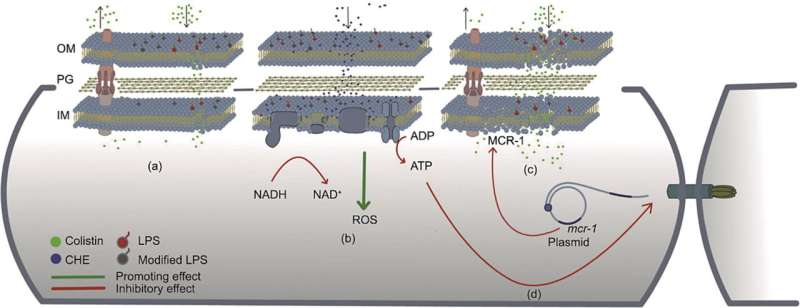This article has been reviewed according to Science X's editorial process and policies. Editors have highlighted the following attributes while ensuring the content's credibility:
fact-checked
proofread
Research team discovers dual effects of chelerythrine in fighting mobile colistin resistance

A research team from China has made an innovative discovery in the fight against mobile colistin resistance. Their study, published in Engineering, reveals the dual effects of feed-additive-derived chelerythrine in combating the spread of the mcr-1 gene, which poses a challenge to the use of colistin, a last-resort antibiotic. This finding opens up new possibilities for enhancing the efficacy of colistin and limiting resistance-gene transmission.
Colistin is a crucial antibiotic used to treat severe infections caused by extensively drug-resistant (XDR) Gram-negative pathogens. However, the emergence and spread of the mcr-1 gene and its variants have rendered colistin less effective against these pathogens.
In response to this challenge, the research team explored the potential of antibiotic adjuvants to enhance the effectiveness of colistin. Their study focused on the effects of chelerythrine, a compound derived from Macleaya cordata extract commonly used as an animal feed additive.
The team discovered that chelerythrine, at a concentration of 4 mg∙L−1, significantly reduced the minimal inhibitory concentration (MIC) of colistin against an mcr-1 positive E. coli strain by 16 folds. This reduction is a promising development in combating colistin-resistant pathogens.
In addition, chelerythrine eliminated approximately 104 colony-forming units (CFUs) of an mcr-1-carrying strain in a murine intestinal infection model. Moreover, it inhibited the conjugation of an mcr-1-bearing plasmid in vitro by more than 100 folds and in a mouse model by up to 5 folds.
The researchers conducted a detailed analysis to understand the mechanism behind chelerythrine's dual effects. They found that chelerythrine binds to phospholipids on bacterial membranes, increasing cytoplasmic membrane fluidity.
This alteration impairs respiration, disrupts the proton motive force (PMF), generates reactive oxygen species (ROS), and decreases intracellular adenosine triphosphate (ATP) levels. As a result, chelerythrine downregulates the mcr-1 gene and conjugation-associated genes, limiting the spread of mobile colistin resistance.
The implications of this discovery are far-reaching. The dual effects of chelerythrine expand the potential of antibiotic adjuvants, providing a new strategy for combating mobile colistin resistance. This breakthrough may also serve as a reference for future antimicrobial and adjuvant development. By identifying the antimicrobial-resistance-combating effects of known compounds, researchers can explore additional ways to combat the growing threat of antibiotic resistance.
The research team's findings have significant implications for the field of medicine and public health. As antibiotic resistance continues to rise, innovative strategies like chelerythrine's dual effects offer hope in the ongoing battle against drug-resistant pathogens. Further research and development in this area may lead to the discovery of new adjuvants and therapies that can effectively combat mobile colistin resistance.
The study conducted by the Chinese research team serves as a testament to the importance of interdisciplinary collaboration and the potential of exploring natural compounds for antimicrobial purposes. By harnessing the power of nature and understanding the mechanisms of action, scientists can unlock new strategies to address the global threat of antibiotic resistance.
More information: Huangwei Song et al, Dual Effects of Feed-Additive-Derived Chelerythrine in Combating Mobile Colistin Resistance, Engineering (2023). DOI: 10.1016/j.eng.2023.06.012
Provided by Engineering


















